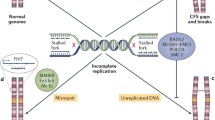Summary
The expression of folate sensitive common fragile sites was investigated in 82 normal healthy males and females of various ages. In 100 studied metaphases of each of these controls, between 0 and 56 lesions were detected (mean 18.3 ± 10.3 SD). No significant difference was found between the mean number of expressed lesions in females and males. No age-effects were observed. Two “new” common fragile sites were discovered at 6p21 and 17q21. Their fragile site status, however, needs to be confirmed.
Similar content being viewed by others
References
Bender MA, Preston RJ, Leonard RC, Pyatt BE, Gooch PC (1989) Chromosomal aberration and sister-chromatid exchange frequencies in peripheral blood lymphocytes of a large human population sample. Mutat Res 212:149–154
Butler MG (1990) No significant relationship between age and frequency of chromosome lesions in mentally retarded individuals with or without the fragile X syndrome. Hum Genet 84:216–217
Craig-Holmes AP, Strong LC, Goodacre A, Pathak S (1987) Variation in expression of aphidicolin-induced fragile sites in human lymphocyte cultures. Hum Genet 76:134–137
Esposito D, Fassina G, Szabo P, De Angelis P, Rodgers L, Weksler M, Siniscalco M (1989) Chromosomes of older humans are more prone to aminopterine-induced breakage. Proc Natl Acad Sci USA 86:1302–1306
Hecht F (1986) Rare, polymorphic and common fragile sites: a classification. Hum Genet 74:207–208
Hecht F, Ramesh KH, Lockwood DH (1990) A guide to fragile sites on human chromosomes. Cancer Genet Cytogenet 44:37–45
Kadotani Y, Watanabe Y, Kurosaki N, Kobashi H, Nagai H (1989) The chromosome fragility in the parents and their babies. Proc Jpn Acad 65:95–97
Kao-Shan CS, Fine RL, Whang-Peng J, Lee EC, Chabner BA (1987) Increased fragile sites and sister chromatid exchanges in bone marrow and peripheral blood of young cigarette smokers. Cancer Res 47:6278–6282
Kishi K, Homma A, Kawa A, Kadowaki K (1987) Age related change in the frequency of Ara C-induced chromosome aberrations in human peripheral blood lymphocytes. Mech Ageing Dev 37:211–219
Marlhens F, Achkar WAI, Aurias A, Couturier J, Dutrillaux AM, Gerbault-Sereau M, Hoffschir F, Lamoliatte E, Lefrancois D, Lombard M, Muleris M, Prieur M, Prod'homme M, Sabatier L, Viegas-Péquignot E, Volobouev V, Dutrilleaux B (1986) The rate of chromosome breakage is age dependent in lymphocytes of adult controls. Hum Genet 73:290–297
Norman A, Bass D, Roe D (1985) Screening human populations for chromosome aberrations. Mutat Res 143:155–160
Rao PN, Heerema NA, Palmer CG (1988) Fragile sites induced by FUdR, caffeine, and aphidicolin. Hum Genet 78:21–26
Sinha AK, Linscombe VA, Collapudi BB, Jersey GC, Flake RE (1986) Cytogenetic variability of lymphocytes from phenotypically normal men: influence of age, smoking, season, and sample storage. J Toxicol Environ Health 17:327–345
Smeets DFCM, Scheres JMJC, Hustinx TWJ (1986) The most common fragile site in man is 3p14. Hum Genet 72:215–220
Smeets D, Verhagen A, Hustinx T (1989) Familial and individual variation in chromosome fragility. Mutat Res 212:223–229
Sugio Y, Kuroki Y (1989) Family study of common fragile sites. um Genet 82:191–193
Tawn EJ (1987) The frequency of chromosome aberrations in a control population. Mutat Res 182:303–308
Webb T (1989) The epidemiology of the fragile X syndrome. In: Davies KE (ed) The fragile X syndrome. Oxford University Press, Oxford, pp 40–55
Author information
Authors and Affiliations
Rights and permissions
About this article
Cite this article
Smeets, D.F.C.M., Merkx, G. Neither age nor sex influence the expression of folate sensitive common fragile sites on human chromosomes. Hum Genet 86, 76–78 (1990). https://doi.org/10.1007/BF00205178
Received:
Issue Date:
DOI: https://doi.org/10.1007/BF00205178




